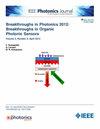Forward Predicting Chromatic-Optical Parameters of the Mixed Light of White-Red Light-Emitting Diode Configurations Based on Deep Learning Algorithms
IF 2.1
4区 工程技术
Q3 ENGINEERING, ELECTRICAL & ELECTRONIC
引用次数: 0
Abstract
This paper presents a novel deep learning framework that integrates experimental measurements with advanced modeling techniques to predict key optical parameters, including luminous flux, correlated color temperature (CCT), and chromaticity coordinates of white-red light-emitting diodes (LED) configurations under diverse operating conditions. The heatsink temperature, white LED driving current, and red LED driving current were each varied systematically to generate a comprehensive set of 5,166 spectral power distribution (SPD) measurements. This dataset, partitioned into training (4,182 data sets) and testing (984 data sets) sets, encapsulates the complex physical mechanisms influencing LED performance, such as temperature-induced spectral shifts and current-dependent optical behavior. Four deep learning algorithms were evaluated. Each model was trained to reconstruct the SPD curves and predict the corresponding optical and chromatic parameters. Our results indicate that Long Short-Term Memory Network (LSTM), Convolutional Neural Network (CNN), and Autoencoder (AE) outperform Backpropagation Neural Network (BP-NN), with CNN achieving the highest accuracy in predicting SPD curves and LSTM achieving the highest accuracy in predicting the optical and chromatic parameters. Furthermore, By mimicking the effects of varying red phosphor ratios through independent control of red LED output, our approach can provide deeper insights into the underlying physical phenomena governing LED spectral behavior. This integrated methodology not only enhances our understanding of the interplay between operating conditions and LED performance but also offers a robust predictive tool for the design and optimization of next-generation LED lighting technologies.基于深度学习算法的白红发光二极管混合光色光学参数前向预测
本文提出了一种新的深度学习框架,该框架将实验测量与先进的建模技术相结合,以预测关键光学参数,包括光通量、相关色温(CCT)和不同操作条件下白红发光二极管(LED)配置的色度坐标。系统地改变散热器温度、白光LED驱动电流和红光LED驱动电流,以产生一套全面的5166个光谱功率分布(SPD)测量值。该数据集分为训练集(4182个数据集)和测试集(984个数据集),封装了影响LED性能的复杂物理机制,如温度引起的光谱移位和电流依赖的光学行为。评估了四种深度学习算法。对每个模型进行训练,以重建SPD曲线并预测相应的光学和色彩参数。我们的研究结果表明,长短期记忆网络(LSTM)、卷积神经网络(CNN)和自编码器(AE)优于反向传播神经网络(BP-NN),其中CNN在预测SPD曲线方面达到最高精度,LSTM在预测光学和色彩参数方面达到最高精度。此外,通过独立控制红色LED输出来模拟不同红色荧光粉比例的影响,我们的方法可以更深入地了解控制LED光谱行为的潜在物理现象。这种集成方法不仅增强了我们对工作条件和LED性能之间相互作用的理解,而且为下一代LED照明技术的设计和优化提供了强大的预测工具。
本文章由计算机程序翻译,如有差异,请以英文原文为准。
求助全文
约1分钟内获得全文
求助全文
来源期刊

IEEE Photonics Journal
ENGINEERING, ELECTRICAL & ELECTRONIC-OPTICS
CiteScore
4.50
自引率
8.30%
发文量
489
审稿时长
1.4 months
期刊介绍:
Breakthroughs in the generation of light and in its control and utilization have given rise to the field of Photonics, a rapidly expanding area of science and technology with major technological and economic impact. Photonics integrates quantum electronics and optics to accelerate progress in the generation of novel photon sources and in their utilization in emerging applications at the micro and nano scales spanning from the far-infrared/THz to the x-ray region of the electromagnetic spectrum. IEEE Photonics Journal is an online-only journal dedicated to the rapid disclosure of top-quality peer-reviewed research at the forefront of all areas of photonics. Contributions addressing issues ranging from fundamental understanding to emerging technologies and applications are within the scope of the Journal. The Journal includes topics in: Photon sources from far infrared to X-rays, Photonics materials and engineered photonic structures, Integrated optics and optoelectronic, Ultrafast, attosecond, high field and short wavelength photonics, Biophotonics, including DNA photonics, Nanophotonics, Magnetophotonics, Fundamentals of light propagation and interaction; nonlinear effects, Optical data storage, Fiber optics and optical communications devices, systems, and technologies, Micro Opto Electro Mechanical Systems (MOEMS), Microwave photonics, Optical Sensors.
 求助内容:
求助内容: 应助结果提醒方式:
应助结果提醒方式:


